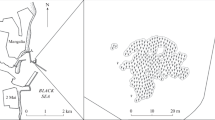Abstract
During late February to mid-March, 1991, when matureN. japonica swarmed in the sea surface off Jimo County, Qingdao, seawater containing numerous early embryos was pumped into a nearby 2.7 ha. muddysand shrimp pond, where the embryos continued to develop. 800000Penaeus chinensis seedlings were introduced into the pond on May 30, 1991. Monthly benthic samplings were carried out to determine the population dynamics and production ofN. japonica in this atypical environment.
The density ofN. japonica varied from 0 to 20 400 ind./m2. The predation ofP. chinensis was considered to be responsible for the mass mortality ofN. japonica in June through July, when the worms were 2.2–3.3cm in length and lived in the top 2–4cm sediment. From August to September of 1991, the hottest period in the site, there was no substantial mortality ofN. japonica as reported in earlier literature. This was explained by the deeper burrowing of the worms that protected them from predation by shrimps.
Monthly biomass ranged from 45.2 to 385.3 g/m2, with a mean of 187.7 g/m2. Production of May. 1991 through March, 1992 was 1071.4 g/m2, with aP/B ratio of 5.7.
Similar content being viewed by others
References
Crisp, D. J., 1971. Energy flow measurements.In: Methods for the study of marine benthos, Holme, N. A. & McIntyre A. D. eds.. Blackwell, Oxford, pp. 197–279.
Gray, J., 1981. The ecology of marine sediments—An introducton to the structure and function of the benthic communities. Cambridge Press, New York, 185 pp.
Inamori, Y. and Kurihara, Y., 1979a. Analysis of the environmental factors affecting the life of the brackish polychaete,Neanthes Japonica (Izuka). I. The effects of the environmental factors on survival and gronth.Bull. Mar. Biol. ST. Asamushi Tohokn Univ. 16 (3): 87–100
Inamori, Y. and Kurihara, Y., 1979b. Analysis of the environmental factors affecting the life of the brackish polychaete,Neanthes japonica (Izuka). II. Thermal and salty conditions required for development and growth.Bull. Mar. Biol. ST. Asamushi Tohoku Univ. 16 (3): 101–112.
Inamori, Y. and Kurihara, Y., 1979c. Analysis of the environmental factors affecting the life of the brackish polychaete,Neanthes japonica (Izuka). III. The effects of the environmental factors on fertilization, cleavage and post-larval development. Bull. Mar. Biol. ST. Asamushi Tohoku Univ.16 (3): 113–121.
Inamori, Y. and Kurihara, Y., 1979d. Analysis of the environmental factors affecting the life of the brackish polychaete,Neanthes japonica (Izuka). IV. The effects of the environmental factors on peristalic movement in burrow.Bull. Mar. Biol. ST. Asamushi Tohoku Univ. 16 (3): 123–127.
Inamori, Y. and Kurihara, Y., 1979e. Analysis of the environmental factors affecting the life of the brackish polychaete,Neanthes japonica (Izuka). V. Thermal alternation as an environmental factor inducing sexal maturation.Bull. Mar. Biol. ST. Asamushi Tohoku Univ. 16 (3): 129–132.
Izuka, A., 1908. On the breeding habit and development ofNereis japonica n. sp., Annot.Zool. Japan 6: 295–305.
Moller, P., 1985. Production and abundance of juvenileNereis diversicolor, and oogenic cycle of adults in shallow waters of western Sweden.J. mar. biol. Ass. U. K. 65: 603–616.
Nagai, S. and Nagai Y., 1981. Population change and growth of the marine polychaetous annelidNeanthes japonica Izuka in a natural habitat.Bull. Japan. Soci. Sci. Fish. 47 (8): 1023–1028.
Sato, M., 1988. Polymorphism in the developmental patterns of polychaetes-Questions around poecilogony and sibling species.Japanese Polychaete Club Letter 8: 23–37.
Sato, M. and Tsuchiya, M., 1985. Reproductive behavior and salinity favorable for early development in two types of the brackish-water polychaeteNeanthes japonica (Izuka),Benthos Research 31: 29–42.
Sato, M. and Tsuchiya, M., 1991. Two patterns of early development in nereid polychactes keying out toNeanthes japonica (Izuka).Ophelia Suppl. 5: 371–382.
Sun, R. P., Wu, B. L. and Yang, D. J., 1980. A study of the morphology and larval development of theNeanthes Japonica (Izuka) from the China Sea.Journal of Shandong College of Oceanology 10(3): 100–109. (in Chinese with English abstract)
Thorson, G., 1950. Reproductive and larval ecology of marine bottom invertebrates.Biological Review 25: 1–45.
Tsuchiya, M. and Kurihara, Y., 1979. The feeding habits and food sources of the deposit-feeding polychaete,Neanthes japonica (Izuka).J. exp. mar. Biol. Ecol. 36: 79–89.ct)
Wu, B. L. and Qiu, J. W., 1992. Production ofPerinereis nuntia (Savigny) at a Qingdao beach.Acta Ecologica Sinica 12(1): 61–67. (in Chinese with English abstract)
Author information
Authors and Affiliations
Rights and permissions
About this article
Cite this article
Jianwen, Q., Baoling, W. Population dynamics and production ofNeanthes japonica (Izuka) in a shrimp pond. Chin. J. Ocean. Limnol. 11, 360–367 (1993). https://doi.org/10.1007/BF02850641
Received:
Issue Date:
DOI: https://doi.org/10.1007/BF02850641




